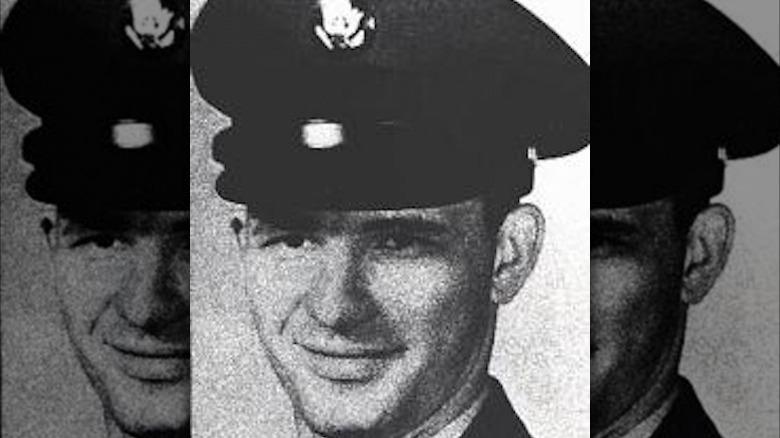The Truth About The Candy Man Killer's Childhood
The following article contains graphic descriptions of sexual assault.
On August 8, 1973, ABC13 writes that Elmer Wayne Henley called the police and stated that he had killed his friend, Dean Corll. What happened next utterly devastated the city of Houston, Texas. According to A&E, police uncovered the remains of 27 young men near the surrounding area where Corll lived. Texas Monthly states they were all between the ages of 13 and 20. Police surmised that each and every victim had been murdered and raped by Corll. This only added to the shock. Those who knew Corll described him as a friendly and polite man. One relative told The Lewiston Daily Sun that he was "a good boy" and that she had "never heard him curse." In fact, most people who had encountered Corll agreed that he was a "nice guy." Of course, the truth was far more sinister than anyone could have ever imagined.
Born in 1939 on Christmas Eve in Fort Wayne, Indiana, Radford University explains that his parents married and divorced each other twice. Even so, The Lewiston Daily Sun reported that the pair "fought and fussed before they got married and they fought and fussed right up to the end." Per All That's Interesting, it's unknown if Corll suffered any abuse while he was a child. However, it's noted that while his father was considered to be a stern man, his mother absolutely adored him.
If you or anyone you know has been a victim of sexual assault, help is available. Visit the Rape, Abuse & Incest National Network website or contact RAINN's National Helpline at 1-800-656-HOPE (4673).
Dean Corll had a close relationship with his mother
After Dean Corll's parents divorced for a second and final time, ThoughtCo writes that he and his family settled in Houston. He was reputedly a good student and was described as a regular boy. Per Radford University, Corll's mother, Mary, remarried and divorced multiple men throughout his life. Texas Monthly suggests that this was because her son was the main man in her life; no one else could compare. All That's Interesting reports that in the 1950s, she ventured into the candy-making business with a new husband.
Corll's mother deeply involved her son in the process, and he helped run the candy factory. In 1964, Corll was drafted into the army (via ThoughtCo). However, he returned home within a year, citing that his mother and their family business needed him. According to Texas Monthly, Corll was known for being friendly with local young boys and often invited them into the candy factory, earning him the nickname "The Candy Man." This led his mother's third husband to believe that he was perhaps a homosexual.
Mary, on the other hand, disagreed and stated (via Texas Monthly), "He was the kind of person who never wanted to get close enough to anyone so they could get ties on him." When a male worker accused Corll of making sexual advances toward him, Heavy states that Mary dismissed him. In 1968, Mary moved to Colorado while Corll stayed behind in Texas (per Texas Monthly). After his mother left, Corll, who was, in fact, gay, began to seek the companionship of teenage boys.
Two teenagers aided him with his murders
Sometime in the 1960s, Dean Corll met David Brooks, then aged 10 or 11, at the candy factory (via Texas Monthly). He became a father figure to the boy and provided him with money and shelter. By the time Brooks was 14, All That's Interesting writes that Corll was sexually abusing him. Then one day, Brooks walked in on Corll assaulting two boys. He left the scene, and Corll later confessed that he had killed them. Corll then asked Brooks to help him lure in other teens to his home so he could molest and murder them. He agreed, and Corll bought him a new Corvette as part of the deal.
Soon after, Brooks introduced Corll to 15-year-old Elmer Wayne Henley. Instead of killing him, Corll took a liking to him and made a similar proposition; if he brought him boys, he would pay him $200 for each one (per Texas Monthly). Henley, intrigued by the thrill of it, agreed. In the early 1970s, ThoughtCo writes that the victims were coaxed by Brooks and Henley to party. They offered rides in Corll's van, free booze, and drugs. Many of Corll's would-be victims were at-risk teens, and several were actually Henley's friends from The Heights neighborhood in Houston. Once the boys made it to Corll's home, they were viciously raped and murdered.
Dean Corll's sadistic nature
Per All That's Interesting, Dean Corll's victims were placed on a "torture board." Texas Monthly writes that this contraption was made out of plywood and had holes in each corner. The victim was then handcuffed to the top holes while their feet were tied with rope through the bottom holes. Additionally, the boys' clothes were taken off, and their mouths were taped shut. Once on the board, Corll mercilessly tortured and assaulted them, sometimes for days. When he was done with them, Corll strangled or shot his victims. David Brooks and Elmer Wayne Henley would then dispose of the bodies using Corll's van.
A&E states that the remains were buried in several mass graves around the Houston area. To avoid suspicion, Texas Monthly reports that the boys were made to write or call their parents to tell them that they were okay. Meanwhile, no one ever suspected that Corll was actually a ruthless serial killer. Despite the high number of missing male teens, the authorities did nothing (via ThoughtCo). Distraught parents were told that their children were troubled runaways and that nothing could be done. By 1973, Corll's killing spree had skyrocketed. Per Texas Monthly, Henley later stated, "It was like a blood lust."
He was killed by his own accomplice
In the summer of 1973, Texas Monthly reports that David Brooks and Elmer Wayne Henley began to drift apart from Dean Corll. Brooks left the Houston Heights neighborhood, and Henley wanted out. On August 8, Henley brought Rhonda Williams and Tim Kerley to Corll's home (via All That's Interesting). Henley has gone on to say that he never intended them to be victims; he simply wanted to have a good time with his friends. The three drank, got high, and passed out. When they woke up, Corll had tied all of them up, including Henley. Corll was furious that he had brought Williams, a girl, to his home.
According to ThoughtCo, Henley told Corll that if he untied him, he would kill Williams and Kerley. Corll agreed and then proceeded to assault Kerley. In the midst of the chaos, Henley was able to grab Corll's gun. He pointed it at Corll and exclaimed (per Texas Monthly), "I can't go on any longer. I can't have you kill all my friends." Henley then shot Corll six times, killing him. The police were called to the scene, and Henley confessed that Corll was a torturer and killer. Shortly after, Henley and Brooks admitted that they too were involved in the murders. Per CBS News, the police subsequently began uncovering the numerous remains of the victims. Within days, they had found 27 bodies buried in a boat stall, a shed, and on the beach. The media quickly coined the killings the "Houston Mass Murders."
The aftermath of the Candy Man murders
For their involvement in the crimes, ThoughtCo writes that David Brooks was convicted of one murder while Elmer Wayne Henley was convicted of six. Per Investigation Discovery, Henley was not charged with Dean Corll's death, as it was deemed an act of self-defense. Nonetheless, Texas Monthly states that they were both found guilty and sentenced to life in prison in 1974. At the time, Henley was 18 while Brooks was 19 (via The New York Times). Despite the clear-cut evidence that Corll was a cold-blooded killer, his mother insisted that her son was innocent. Per Texas Monthly, she later described him to a Houston Post reporter as "loyal, obedient, helpful, loving, and a good normal boy."
According to A&E, the Houston police department was denounced for not investigating the disappearances of the missing boys. One victim advocate stated (per the Houston Chronicle), "There really wasn't any effort made to locate (them)." In 2009, a 28th victim was identified using DNA testing. His remains were found in 1983. This new discovery prompted the belief that Corll may have had more victims than just the ones that have been discovered.
Now, Texas EquuSearch, a non-profit, is searching for more possible victims. They wrote to Henley, who agreed to help them in any way he can. Although they dug up the backyard of Corll's former residence in November 2021, the team failed to find anything. David Brooks died in 2020 from COVID-19.





